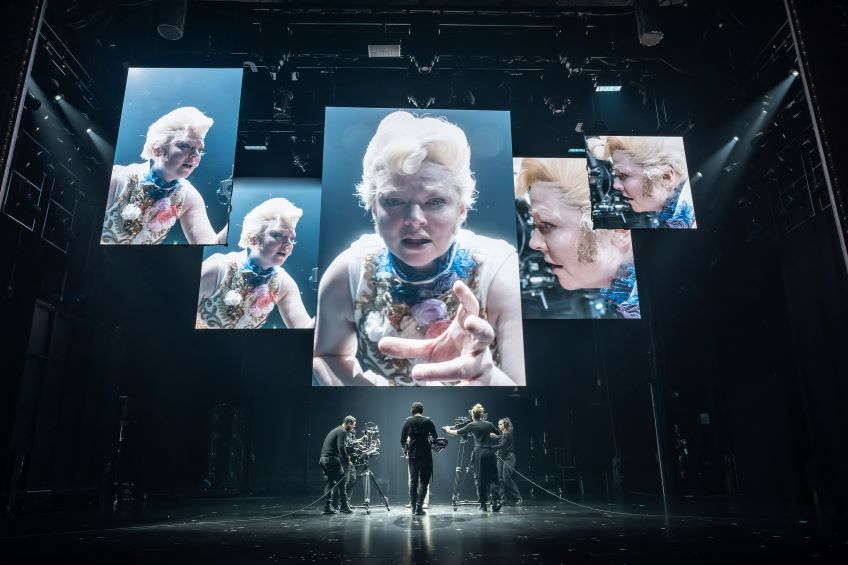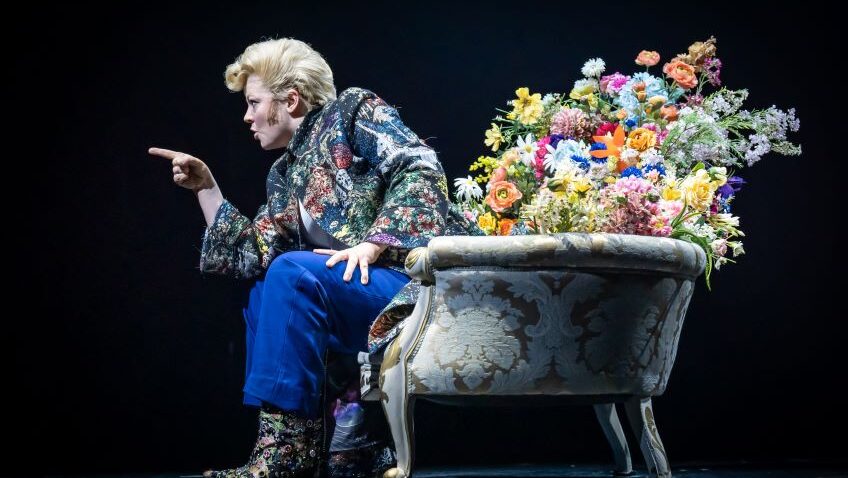The sustained impact of Sarah Snook’s charismatic performance, combined so superbly with an artistically choreographed integration of stage-wide screen technology, reaches the realms of awesome at times and inspires genuinely spontaneous, elated ovations.
In The Picture of Dorian Gray only one actor sets foot on the stage, only one actor acts, yet two dozen characters people the play, moving onstage, upstage, downstage, across the stage and way up on high above the stage, their facial expressions and body language writ large for us to share and absorb. A score of black-clad camera-operators/prop-bearers/costume and set changers move across the floor in splendidly choreographed synchronicity with each other and with Snook, as live footage of Snook from all angles and distances, including the closest of intimate, unflattering close-ups, fills the huge, dangling, flat screens that move, cross and merge in their own gliding dances. As she’s filmed, Snook is often half hidden by screens, the full picture appearing in intimate detail onscreen, almost as if this were a cinema screening. As they interact and merge with each other and with pre-recorded footage of the actress in her various guises or in photo-shopped portrait shots, she is everyone at once. Live onstage, she changes wigs and outfits, voice and demeanour, taking up cigarette or paintbrush and, in a trice and in elegant flow, she becomes some of those same characters – primarily Dorian Gray, Sir Henry, Basil – or, in brisk asides, she’s our textual narrator in the style of a dramatic Radio 4 reading.

Costumes, appropriate to the era (Wilde’s Gothic novel was published in 1890) are adorned with colourful, surreal elements, while the tone of this dark, fantastical horror story of torment, debauchery and murder starts out light, jaunty and comical as the characters are introduced: Snook gives a cheeky wink as bubble-haired blond, naive boy, Dorian Gray, and provides spoof send-ups, too, of nervous artist, Basil, as he paints the beautiful boy‘s portrait, and of malevolent smoker and manipulator Sir Henry, out to corrupt young Dorian. There’s amusing puppetry in the mix, too. All the characters are not rounded, thoroughly believable beings but they don’t need to be, especially as comedy recedes and Dorian progresses through his journey of degeneration. In his total obsession with retaining youth and beauty as he indulges in every corrupt pleasure and whim he still looks like an angel, but he loses his very soul and the portrait in the attic grows more horrendously repulsive and distorted with every sin he commits. Tension builds, and by the end, the audience passes with Dorian (courtesy of super Snook) through a wringer of despair and intense, tortured emotion.
The music and sound are superbly evocative, too: Mozart’s powerful Requiem and Vivaldi’s Four Seasons heighten intense emotions while Jimmy Somerville’s I Feel Love is just right for frenetic scenes of garish, hedonistic abandonment to drugs and debauchery. At one point only do all screens and music disappear altogether – and to great effect: towards the end, after chasing through extensive woodland that leaps us from screen to screen to screen, Dorian is suddenly alone, facing a silent, motionless hare at the mercy of the hunters. This exclusive moment allows his mind, and ours, to focus fully on reality before heading to the devastating climax.
In our own brainwashed day and age with its increasing obsession with youth, beauty and image, and the broadcast of manipulated, misleading images, this partnership of classic story with a whole range of modern technology (Snook also operates a phone to frighteningly distort and enhance the onscreen images) is particularly apposite, while Snook’s focused virtuoso performance ensures all comes together with horribly delightful, artistically pleasing impact over two hours with no break. And that’s the way to do it. Astonishingly good.
Eileen Caiger Gray




